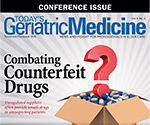 |
2015–2020 Dietary Guidelines for Americans: Implications for Older Adults
Based on the newly developed 2015–2020 guidelines, experts offer recommendations on dietary patterns designed for optimal nutrition among older adults. Read more »
Elder Suicide Intervention
High rates of geriatric suicide require that providers become familiar with screening, education, and prevention strategies. Read more »
New Approach to Assess Elders’ Balance
A group of professors and students collaborated in designing a device that will be able to detect potential balance issues through a smartphone application. Read more » |
 |
 |
Spotlight on Diabetes
As we observe Diabetes Awareness Month, it’s important to focus attention on a disease that continues to exact a devastating toll on older adults. Diabetes management is critical to the overall health and function of older patients.
During my training in the late 1990s, patients who suffered the worst end-organs damage from diabetes fell into the ominous sounding category “triple-opathy.” That was house officer-speak for the presence of the three most common end-organ conditions: nephropathy, neuropathy, and retinopathy. Unfortunately, as bad as we thought diabetes was at that time, we now know we were underrecognizing the ravages attributable to this illness.
There is a growing understanding that the cascade of insulin-involved pathologies along with other cardiometabolic risk factors affects cerebral tissues in ways similar to the destruction of renal and retinal tissues, and ultimately contribute to cerebral dysfunction and dementia. As the size of the expansive elderly population continues to soar, so too does the number of individuals with diabetes and dementia.
Read more » |
 |
 |
HOME Medical Alert System
With AutoFALL Fall Detection
A lightweight waterproof fall-detection pendant, AutoFALL technology offers the security of automatic fall detection, sensing the difference between a “drop” and an actual fall. Using sensors and software, the AutoFALL pendant can detect a fall and signal the medical alert console to initiate a call to the emergency response center. The device includes an extra button to wear or keep in the bathroom. Learn more »
CogniSense
CogniSense, a digital cognitive assessment tool, aids in a physician’s assessment, diagnosis, and care management of individuals with cognitive dysfunction. CogniSense is designed to overcome several limitations of conventional paper-based cognitive assessment, such as lack of objective easily trackable data over time and integration to electronic health records. Its features enhance the efficiency and ease of cognitive assessment, particularly in a primary care setting. It provides health care practitioners a digitized version of the Memory Orientation Assessment Test to assess a patient’s memory, orientation, sequential memory, and time through the use of memory recall techniques, information comprehension tests, and tablet-based clock drawing. Available as an app for Apple’s iPad, CogniSense is administered and scored electronically, providing an objective baseline score and progressive scores that can be stored in Care360, Quest’s lab-ordering platform, and any of nearly 600 other electronic medical records that connect to Quest. As part of a patient’s medical record, results from CogniSense allow clinicians to track and monitor a patient’s cognitive function over time. Learn more » |
 |
 |
| Have a question you want answered by one of our experts? Send your question to TGMeditor@gvpub.com and it may be featured in an upcoming e-newsletter or print issue. |
 |
|
|
 |
 |
A Secure, Anonymous Résumé Bank
Job Alerts Sent to Your E-mail |
 |
 |
National Report Calls for Better Resources
for Caregivers
An article in Pittsburgh’s Tribune-Review highlights the difficulties related to family caregiving, as described in a new study that analyzed the problems.
Men Get Osteoporosis, Too
Physicians must be aware that elderly men as well as women are at risk for developing osteoporosis, according to an article in The New York Times.
Hospital Readmissions Decline in Ohio, Nationwide
Improved discharge planning, financial assistance with prescription medications, and home visits have helped to reduce hospital readmissions, according to an article in The Columbus Dispatch.
Drivers Older Than 85 Are Fastest-Growing Group on the Road
An article in the Los Angeles Times reports that people older than 85 comprise the fastest-growing group on US roads. |
 |
 |
 |
Set up Job Alerts and create your online Résumé
to let potential employers find you today! |
 |
 |
Have a product or service you want to market to geriatricians, other physicians and the geriatric care team of professionals who treat aging patients? Are you a recruiter looking to fill the many geriatric professional openings within a facility, physician practice or academic institution? Then utilize the reach of Today's Geriatric Medicine to accomplish your marketing goals and fill any open positions.
Coming up in our March/April 2017 issue is our Spring Showcase. Contact sales for more information.
A resource for professionals looking for new opportunities, as well as those physicians just curious to see what's out there, our Physician Recruitment Center gives physician recruiters a powerful tool to fill partnership opportunities, academic appointments, and hospital staff positions. To support your product marketing or recruiting needs, e-mail our experienced account executives today at sales@gvpub.com for more information or call 800-278-4400! |
 |
|
